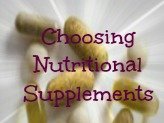Nutrients and Their Functions
Nutrients are the essential substances needed by the body to perform its daily functions properly. Each has a special purpose and thus meets a specific need in the body.
These essential substances provide energy, forms new body components, and assist in the metabolic processes of the body.
Different foods contain different kinds and quantities, and therefore you need to eat a variety of foods to be able to get enough of what your body needs.
Here are some facts about major nutrients; including what they contribute to good health and in what foods they are found:
Carbohydrates
-Supply energy (4 calories per gram).
-Spare proteins to be used for growth and maintenance of body tissues rather than energy.
-Provides fiber.
Food sources include: complex carbohydrate foods include breads, cereals, pasta, rice, and starchy vegetables such as potatoes, green beans, corn, and lima beans. Simple carbohydrate foods include sugar, honey, syrup, candy, soft drinks, icings, and fruit.
Proteins
-Build and repair body tissues.
-Help antibodies fight infection.
-Supply energy (4 calories per gram) if more of these nutrients are consumed than needed to build and repair body tissues
Food sources include: meat, poultry, fish, eggs, milk, yogurt, cheese, dried beans and peas, and nuts and nut butters.
Vitamins
- Vitamin C (Ascorbic Acid)
-Helps form cementing substances such as collagen that hold body cells together, thus strengthening blood vessels and hastening healing of wounds and bones.
-Increases resistance to infections
-Helps body absorb iron in the diet.
Food sources include: cantaloupe, grapefruit, grapefruit juice, honeydew melon, kiwi fruit, mandarin orange sections, mango, orange juice, papaya, strawberries, tangerines, asparagus, broccoli, brussels sprouts, cabbage, cauliflower, kale, sweet green and red peppers, sweet potatoes.
Learn more about vitamin C here...
- Thiamin (B1)
-Helps body cells obtain energy from food.
-Helps keep nerves healthy
-Promotes good appetite and digestion.
Food sources include: meat, poultry, fish, dried beans and peas, nuts, enriched and whole-grain breads and cereals.
- Riboflavin (B2)
-Helps cells use oxygen to release energy from food.
-Helps keep eyes healthy and vision clear.
-Helps keep skin around mouth and nose healthy.
Food sources include: milk, liver, meat, poultry, fish, eggs, and green leafy vegetables.
- Niacin (B3)
-Helps cells use oxygen to release energy from food.
-Maintains health of skin, tongue, digestive tract, and nervous system.
Food sources include: liver, meat, poultry, and fish, peanuts and peanut butter, dried beans and dried peas, and enriched and whole-grain breads and cereals.
- Vitamin A
-Helps keep eyes healthy and able to adjust to dim light.
-Helps keep skin healthy
-Helps keep lining of mouth, nose, throat and digestive tract healthy and resistant to infection.
-Promotes growth.
Food sources include: liver, dark green and deep yellow vegetables (such as broccoli, collards and other green leafy vegetables, carrots, pumpkin, sweet potatoes, winter squash), butter and fortified margarine, whole milk, vitamin A-fortified nonfat milk, and vitamin A-fortified low-fat milk.
- Vitamin D
-Helps body absorb calcium.
-Helps body build strong bones and teeth.
Food sources include: vitamin D-fortified milk.
In addition, exposure to sunlight is another source of Vitamin D. Of all the other nutrients, Vitamin D is produced in the skin with stimulus of sun.
- Vitamin E
-Active in maintaining the involuntary nervous system, vascular system, and involuntary muscles.
Food sources include: vegetable oils, margarine made from vegetable oils.
- Vitamin K
-Necessary for proper blood clotting.
sources include: green leafy vegetables, milk, meat, eggs.
Folate (Folic Acid or Folacin)
-Helps body produce normal red blood cells.
-Helps in the biochemical reactions of cells in the production of energy.
-Reduces the risk of neural tube birth defects in newborns
Food sources include: most enriched breads, flour, corn meal, pasta, rice and other grain products; vegetables; mustard and turnip greens; liver; citrus fruit juices; and legumes.
- Biotin
-Essential in the breakdown of nutrients like carbohydrates, lipids, and proteins in the body.
Food sources include: liver, kidneys, egg yolk, vegetables and fruits (especially bananas, grapefruits, watermelon, and strawberries).
- Pantothenic Acid
-Aids in the metabolism of fat.
-Aids in the formation of cholesterol and hormones.
Food sources include: liverwurst, meats, poultry, egg yolk, wheat germ, rice germ, tomato paste, sweet potatoes, oatmeal, and milk.
- Pyridoxine (B6)
-Needed to help nervous tissues function normally.
-Helps to maintain the health of the skin and red blood cells.
-Assists in the metabolism of proteins, carbohydrates, and fats.
Food sources include: liver, lean meats, cereals, vegetables, and milk.
- Cyanocobalamin (B12)
-Necessary in the development of normal growth.
-Helps in the metabolism of folate.
-Helps protect against pernicious anemia. (Pernicious anemia primarily results from the body’s inability to absorb vitamin B12. However, it can result from a deficiency of vitamin B12 in the diet.)
Food sources include: liver, fish and seafood, meats, eggs, chicken, and milk.
Fats
-Supply the most concentrated source of energy (9 calories per gram).
-Carry fat-soluble vitamins A, D, E, and K.
-Provide feeling of fullness and satisfaction since fats take longer to digest.
Food sources include: oils, shortening, butter, margarine, mayonnaise, salad dressings, table cream, and sour cream.
Macro-mineral Nutrients
- Calcium
-Needed for bone rigidity.
-Helps in blood clotting.
-Aids in muscle contraction, normal nerve functions.
Food sources include: milk (nonfat, lowfat, and whole), yogurt, cheese, green leafy vegetables such as kale, collards, mustard greens, and turnip greens.
- Phosphorous
-Helps build strong bones and teeth.
-Aids in all phases of calcium metabolism.
Food sources include: meat, poultry, liver, fish, eggs, milk, other dairy products, grain products, lima beans, legumes, nuts and seeds.
- Magnesium
-Helps regulate body temperature, muscle contractions, and the nervous system.
-Helps cells utilize carbohydrates, fats, and proteins.
Food sources include: green leafy vegetables, nuts (including brazil nuts, almonds, and cashews), meats, beef liver, salmon, cheddar cheese, milk, eggs, and dry beans and peas.
- Sodium, Chloride, Potassium
These three work together to:
-Regulate the flow of fluids in the body.
-Help regulate the nervous system.
-Help regulate the muscle functions, including heart.
-Help regulate nutrients absorption in the cells.
Food sources include: sodium and chloride are found in table salt. Potassium is found in meats, milk, bananas, leafy green vegetables, and citrus fruits.
Micro-mineral Nutrients
- Iron
-Combines with protein in the blood to form hemoglobin. Food sources include: liver and other organ meats, egg yolks, dried legumes, ground beef, leafy green vegetables, shellfish, enriched breads, fortified cereals.
- Zinc
-Plays an important role in the formation of protein in the body, thus assists in wound healing, blood formation, and general growth and maintenance of all tissues.
Food sources include: oysters, organ meats, beef, pork, chicken, turkey, wheat germ.
- Copper
-Necessary in the formation of hemoglobin.
Food sources include: liver, shell fish, nuts and seeds, prunes, whole-wheat grain and bran products, barley, lima beans, white and sweet potatoes, tomato juice, and turnip greens.
- Manganese
-Necessary for normal development of bones and connective tissues.
Food sources include: nuts, rice, whole grains, beans, and leafy green vegetables.
- Selenium
-Works in conjunction with vitamin E to protect cells from destruction.
Food sources include: fish, organ meats, shellfish, eggs, and grains and plants grown in selenium-rich soil.
- Chromium
-Maintains normal glucose uptake into cells.
-Helps insulin bind to cells.
Food sources include: vegetable oils, egg yolks, whole grains, and meats.
- Iodine
-Needed by thyroid gland to produce thyroxine, which is essential for the oxidation rates of cells.
Food sources include: iodized salt, ocean fish, seaweed, and milk.
- Fluoride
-Helps reduce incidence of tooth decay.
Sources include: fluoridated drinking water, seafood, tea, fruits and vegetables grown in areas where natural fluoride level in the water is high, and fluoridated toothpaste.
- Water
-Is essential for life.
-Represents two-thirds of our body weight.
-Is part of every living cell.
-Is the medium for all metabolic changes (digestion, absorption, and excretion).
-Transports nutrients and all body substances.
-Helps maintain body temperature.
-Acts as a lubricant.
Sources include: drinking water, liquid foods, water in foods, and water released when carbohydrates, protein, and fats are metabolized in the body.








New! Comments
Have your say about what you just read! Leave me a comment in the box below.